








Exhibitions - Fall 2002
September 21 |
Photographs by Bill McDowell |
September 21 |
3D Photographs by Ron Labbe |
| September 26 - November 2 |
Soulful Pieces: Memory Jars and Improvised Quilts by Unknown Makers |
| September 26 - November 9 |
Good Will: Engravings from Boydell's Illustrations of the Dramatic Works of Shakespeare |
| November 7 - December 20 |
Eddie Breen: Piggyback Art from the Murray Randle Collection |
| November 7 - December 20 |
A Boy and His Agenda Installation and Performance by Alexei Boulokhov '03 |
| November 13 - December 20 |
Sue Coe: Ship of Fools |
Inside the Blue Line
Photographs by Bill McDowell
- August 19 - September 21, 2002
- Related Educational Programs

toned gelatin silver print, 43 x 43 inches
-
Several things attracted me to the idea of photographing within New York�s Adirondack Park. At over six million acres, it is the largest nature preserve in the lower forty-eight states, and one of the oldest. Perhaps nowhere else can one so accurately track the changes in the ethics of land use.
In pre-colonial times, the Iroquois (Haudenosaunee) used the Adirondacks mainly for hunting because they deemed the region too harsh and barren for year-round living. When the Lewis and Clark Expedition reached the Pacific coast in the early 1800s, the Adirondacks had been little explored by Europeans. But by mid-century, painters and writers had begun to romanticize the rugged landscape and its inhabitants, and the region grew increasingly popular as a tourist destination.
In the 1880s, extensive clear-cutting of forestlands prompted the New York State Legislature to create the Adirondack Forest Preserve. The state established the Adirondack Park in 1892, incorporating the public Forest Preserve and private lands surrounding it. Three years later, voters amended the state Constitution to declare the Forest Preserve �forever wild.� Because the Adirondack Park�s original boundaries--designated on a map by a blue line--included public and private lands, an uneasy alliance was created that continues to test individual and collective ideas regarding land management and preservation.
These photographs refer to and have been inspired by the Adirondacks and its history, but only to serve a broader narrative, that of our irresolute response to the persistence of nature. In resisting the urge to document the story of the Adirondacks, I found visual situations that resonate on multiple levels--pictorially, contextually, and poetically--images that speak to how we experience and contend with nature.
-BM
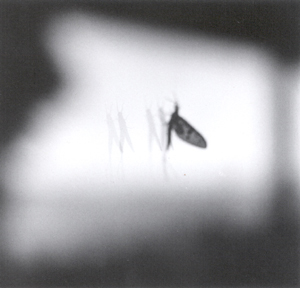
toned gelatin silver print, 43 x 43 inches
Bill McDowell has exhibited photographs internationally and has had one-person shows in Los Angeles, Portland, Houston, and New York. He is a recipient of the 1998 Aaron Siskind Individual Photographer�s Grant, and his work has been published in magazines and journals such as The New Yorker, Art in America, Art Issues, Contact Sheet, and exposure. One of his recent projects, Banner of Light: The Lily Dale Photographs, presents enigmatic images of the Spiritualist community in western New York. McDowell�s photographs are included in several permanent collections, including the International Museum of Photography at the George Eastman House, Rochester, New York, and the Museum of Fine Arts, Houston. He teaches at the University of Vermont and has taught at the Rochester Institute of Technology and Texas A&M University-Commerce.
Stereo Still
3D Photographs by Ron Labbe
- August 19 - September 21, 2002
- Related Educational Programs

- I think that what makes a photograph so powerful is the fact that, as opposed to other forms like video or motion pictures, it is about stillness.
-Joel-Peter Witkin
-
We see thousands of photographs--millions are taken--billions. Anyone can do it. But the stereoscopic photo, it�s rare. The stereo picture attempts to capture more than patterns of color and light. The combined binocular pair recreates in your mind the very space and solid that occupied the original scene. Viewing people photographed this way, so lifelike yet unmoving, can be a bit unnerving at first--they become sculpture. The stereo photo is a diorama for your private, lingering inspection. The space invites your exploration--photography and sculpture are merged�
-RL
Ron Labbe graduated from the Massachusetts College of Art in 1977 with a BFA. Now based in a renovated 1907 New England church in Maynard, Massachusetts, he operates Studio 3D, which provides a comprehensive range of digital, video, and still 3D-imaging services (see www.studio3d.com). Ron writes, �My bio might include having worked on many of the famous MAGIC EYE books (got the guy who started it interested in 3D), the 2000 Sports Illustrated 3D Swimsuit Edition. 3D slide shows for museums--oh, the Dec. issue of the Journal of Neuroanatomy featured images made by me and a Brazilian neurosurgeon while I was actually in the operating room!� In addition, Ron has been collecting stereo imagery, including turn-of-the-century stereocards, View-Master, and 1950s amateur stereo slides for over twenty years.
Soulful Pieces:
Memory Jars and Improvised Quilts by Unknown Makers
- September 26 - November 2, 2002
- Related Educational Programs
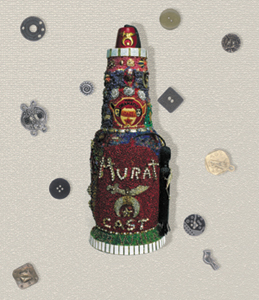
collection of Keith Sadler
- Like life and death, day and night, sky and earth, improvised quilts and memory jars are symbiotic, organic opposites. Colors and patterns in improvised quilts shine like the sun in wakeful joy, while in memory jars, shiny trinkets, buttons and coins peek out shyly and glisten like stars embedded in the night sky. Quilts evoke warmth, life and regeneration through sleep. Memory jars were created as memorials, and also are believed to have functioned as grave decorations or markers in African-American communities in the South.1 As in a dream or in the unconscious mind, the patterns and colors in improvised quilts and the objects in memory jars are both logical and completely random.
Forty quilts and memory jars from eight Chicago collections are included in the exhibition. Intuit: The Center for Intuitive and Outsider Art, where this exhibition originated, was founded in 1991 in Chicago by people passionate about self-taught and outsider art. The quilts and jars are powerful and unique expressions that exemplify a great teaming of thrift and creativity. Although there is an African-American tradition in both improvised quilts and memory jars, these works are all by �anonymous� makers. All we know is what we see in front of us. The aesthetics of improvised quilts and memory jars are similar in that both are composed of fragments, scraps and leftovers that have been recycled and re-energized into new forms. Lost and found again, they are spiritual orphans, sacred relics with their makers� soulful energy.
-Martha Watterson, exhibition curator

Martha Watterson is the associate/outreach director of Intuit: The Center for Intuitive and Outsider Art in Chicago. She previously served as the arts in education program coordinator for the National PTA. A 1991 graduate of St. Lawrence University, she earned a bachelor�s degree in English with a minor in fine arts. Special thanks to the lenders of this exhibition, especially Corrine Riley and Keith Sadler for sharing their passion and excitement for quilts and memory jars. The curator�s gallery lecture and workshop are funded by the Jeanne Scribner Cashin Endowment for Fine Arts.
The gallery will be closed October 10-13 for mid-semester break.
Good Will
Engravings from Boydell's Illustrations
of the Dramatic Works of Shakespeare
- September 26 - November 9, 2002
- Related Educational Programs
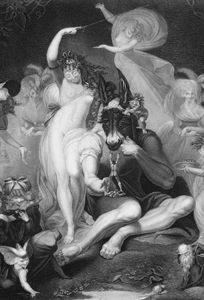
A Midsummer Night's Dream: Act IV, Scene I (detail),
gift of Fred Parker, SLU Permanent Collection X.176
From 1789 to 1805, John and Josiah Boydell commissioned 167 paintings for the Shakespeare Gallery in London by over thirty of �the most eminent artists of Great Britain,� including Sir Joshua Reynolds and Henry Fuseli. Based on these paintings, the Boydells published two volumes of elephant folio engravings in 1805, and an American edition was published in 1852 by Shearjashub Spooner. This exhibition from St. Lawrence University�s Permanent Collection presents 24 of the original 97 prints.

Hamlet: Act I, Scene IV
gift of Fred Parker, SLU Permanent Collection X.163
Special thanks to Greg McMurray and Meghan Weyrens �02 for their curatorial assistance.
Eddie Breen: Piggyback Art from the Murray Randle Collection
- November 7 - December 20, 2002
- Related Educational Programs
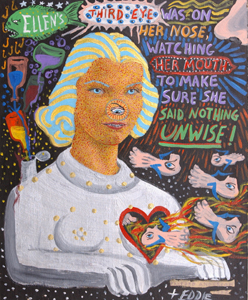
acrylic on oil on canvasboard, 22 5/8 x 18 1/2 in.
-
A year ago Todd Matte introduced me to the wit and chaos of eBay artist Eddie Breen, and we spent a couple of hours surfing through awkward renderings of space aliens (�with very large pores, as most alien imagery incorrectly portrays them with smooth skin,� according to the artist); robotic nuns; penguins of death; an existential poodle sphinx resting on a bed of skulls next to a chicken �Riddler�; rats wielding baseball bats; a woman with a Portuguese man-o-war hairdo; three-eyed sharks; and Jesus as a crash test dummy, Jesus in a crystal ball at a psychic reading, Jesus as Paul Bunyan�s crutch, and Dino Jesus with Australopithecine Satan.
-
Eddie�s �visionary� paintings typically include some sort of hand-scrawled rant: The blackeyed susans had to get a restraining order after being repeatedly pollinated by brutal rats! One rat says, �she loves me not!� -- or -- In art-hell you must paint motif #1 over and over! -- or -- Alien pioneer lady tricks Jesus into lying by asking if he thinks her butt looks too big in these pants! Jesus says, �No!... Yes!... I mean�� -- or -- Hospital gods prescribe a flower helmet to prevent Chris from dwelling on death -- or -- An evildoer bit me�turning me into a Republican.
-
Get the idea?
-
�Breen� in this case is also used as a verb. Scrounging through flea markets and church bazaars, Eddie finds old paintings that are �boring� or �incomplete� and �transform[s] the clumsy work of others into his own brand of �Breen,�� according to Coco McCabe of The Boston Globe. Calling it �piggyback art,� he adds a cheerful �+ EDDIE� to each canvas and posts the paintings on the world�s biggest online marketplace, having sold over 300 to date. You can find out more about this Webcam-totin�, bloggin� outsider artist at www.eddiebreen.com.
-Cathy Tedford
Gallery Director
Artist�s Resum�
1956-98-nothing much happens and Breen never gets into the Whitney Biennial.
Summer 1998-begins painting.
December 2000-show at the Musselman Gallery, Provincetown, MA.
Winter 2001-speaks on a panel at Rhode Island School of Design, �Selling Art on the Internet,� or something like that, sponsored by the alumni office.
Winter 2002-group show, River Gallery, Ipswich, MA.
Current-included in Revelations and Reflections of American Self-Taught Artists, a traveling show organized and circulated by ExhibitsUSA.
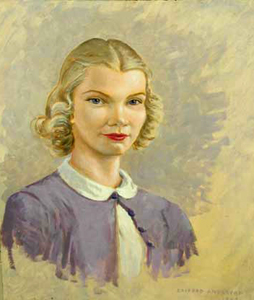
-
�I hope everybody enjoys Eddie�s madness. I don�t know much about art, I�m just an old, degenerate cowboy, but for me, art is all about originality and imagination. Eddie is loaded with both of these.�
- Murray Randle, Granbury, Texas
A Boy and His Agenda:
Installation and Performance by Alexei Boulokhov '03
- November 7 - December 20, 2002
- Related Educational Programs
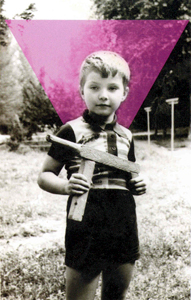
- Growing up gay in the Soviet Union was surprisingly easy. I knew I was �different� but couldn�t get past this adolescent cliché
until the name-calling began. Of all the things to label someone who wore glasses, failed in gym class, read Dostoevsky for fun, and sat on the bench at dances, one word stood out. Goluboi, which literally means light blue, is Russian slang for faggot. For some reason, it seemed to hurt the least, if at all. It fit. How did everyone else know before I did? I am yet to thank my classmates for helping me discover my sexuality. Later I learned about gender coding, homophobia, and hazing.
Once when I was in the fourth grade playing �tag-you�re-it� between classes, I pulled my scarlet Pioneer scarf over my face. �I was just playing American cowboys and Indians.� This innocent confession in the principal�s office sent shock waves throughout the school. To do this with a piece of the Motherland soaked in the blood of fighters for Communism? Where could ideas of such vandalism come from? My parents were accused of raising me in a dissident environment, and I was publicly reproached and grounded for a month. I wondered, �all this over a piece of fabric that doesn�t even match my uniform?�
As a child, I developed an intense awareness of being watched and evaluated based on my looks, manners, and behavior. My sense of otherness made me search for a place to belong. Finally, this past summer I had a homecoming of sorts, just outside of Berlin at the Sachsenhausen concentration camp where Nazis persecuted political prisoners, prisoners of war, artists, ethnic minorities, and homosexuals. There I saw the collision between the state and the individual in terms of authoritarian ideology and sexuality, and I came to understand the lessons of my youth and the power of naming and symbols.
Nur lieben macht frei.
-AB

Love sets you free...
Alexei S. Boulokhov �03 came to St. Lawrence from Novocherkassk, Russia. A speech and theatre major, he has appeared in many stage productions, earning a Joan M. Fuzak Drama Award. He is also a recipient of a St. Lawrence Theological Society Award and a Don Makosky Gender Studies Award for his involvement with the student organization PRIDES (People Recognizing Individuality, Diversity, and Equality of Sexualities) and for his contributions to a safer, more open-minded campus community. His project �Gay Fantasy and Queer Reality: History of Representation of Homosexuality in American Film� was selected in 2001 for a St. Lawrence University Fellows grant. In the summer of 2002, he traveled as a Tanner Fellow to Poland, the Czech Republic, and Germany to research the emergence of queer culture and the gay rights movement in Eastern Europe. With his digital feature film Flamer, a gay coming-of-age story set in a small northern New York town, Alexei was a participant at the Kodak American Pavilion Student Filmmaker Program at the 55th Cannes Film Festival. He plans to pursue graduate studies and a career in the performing arts and �creative activism.�
Sue Coe: Ship of Fools
- Related Educational Programs
- November 13 - December 20, 2002
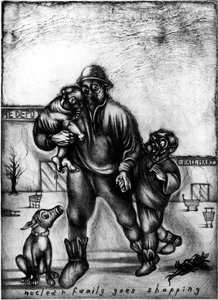
lithograph on heavy white wove paper
-
In 1494, Sebastian Brant, a judicial scholar living in Basel, Switzerland, published a cautionary tract titled The Ship of Fools (Das Narrenschiff). Richly illustrated with woodcuts by an unknown artist or artists, The Ship of Fools was a catalogue of society�s failings as perceived by the author on the eve of the Protestant Reformation. Although drawing upon the traditional Christian repertoire of vices and virtues, Brant expanded the scope of his thesis by seeking examples from an increasingly secular world that included corrupt clergymen, misguided intellectuals, complacent aristocrats, hunters, chefs, vintners, farmers, businessmen, and connoisseurs of base entertainment. These and other characters were the fools journeying on Brant�s ship to certain doom (or Narragonia-the land of fools).
The focal point of this exhibition is, appropriately, Sue Coe�s own interpretation of the �ship of fools� theme. Her overriding goal is �to be a witness to understanding collusion.� Growing up [in England] a block away from a hog slaughterhouse, she began to ask herself how it is that the mechanism and acceptance of death could so pervasively take root in society. As a member of the lower middle class, she saw little difference between herself and the neighboring hogs. The upper classes receive privileges and rewards that encourage them to ignore the painful realities of those weaker than themselves. The lower classes, like hogs, cows, and chickens, have nothing to offer but their bodies, usually in the form of labor. Coe always viewed herself as inert matter, likely to be slaughtered at any moment by the grinding imperatives of class, as carried forth in the labor market, the educational establishment, the military, or any number of capitalism�s byways. And yet, at the same time, Coe could not deny her own complicity in the system. �Every dollar I get drips with blood, too,� she writes.
Coe�s work today is much quieter than it once was. Earlier in her career, she believed that the dissemination of information alone was enough to foment change. Now she recognizes that change comes more slowly, as a result of knowledge derived from cumulative experience. If one thinks solely in terms of ideology, Coe explains, then one is always reacting to the latest onslaught. In the process, one misses the forest for the trees. Today it seems pointless to attack the Reagans and Bushes and Gingriches of the world. Such enemies come and go; the emphasis should not be on them, but on us. What is important is to understand how people manage to survive in our hostile environment, for the most part supporting and caring for one another. Coe believes that the communal structure that will ultimately save humanity in fact already exists, if we only open our eyes wide enough to see it. This is perhaps most obvious in the heroic efforts of people, such as healthcare workers, who stand at the front lines in the battle against human misery, but basic human goodness is also abundantly manifested in the daily efforts of ordinary people to make decent lives for themselves and others.
- Jane Kallir
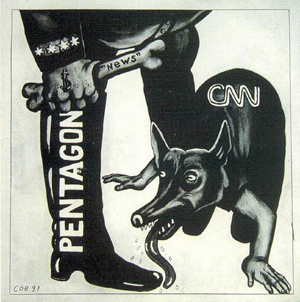
photo-etching on white heavyweight Rives paper
The Nuclear Family Goes Shopping and Newshound, © Sue Coe. The excerpt from Jane Kallir�s essay Ship of Fools (1996) is reprinted with the images courtesy of Galerie St. Etienne, New York. The artist�s lecture at St. Lawrence University is funded by the Jeanne Scribner Cashin Endowment for Fine Arts with special thanks to Melissa Schulenberg.
Gallery hours Monday-Thursday
Friday and Saturday12-8 p.m.
12-5 p.m.
The Richard F. Brush Art Gallery will be closed October 10-13 for mid-semester break.
We welcome individuals and tours for guided tours of the exhibitions and the University�s permanent collection of nearly 7,000 art objects and artifacts. Many visiting artists and curators are available for class visits by scheduling in advance. Please contact Gallery staff for more information.
Catherine Tedford, Director 229-5174 ctedford@stlawu.edu Carole Mathey, Assistant Director 229-5522 cmathey@stlawu.edu